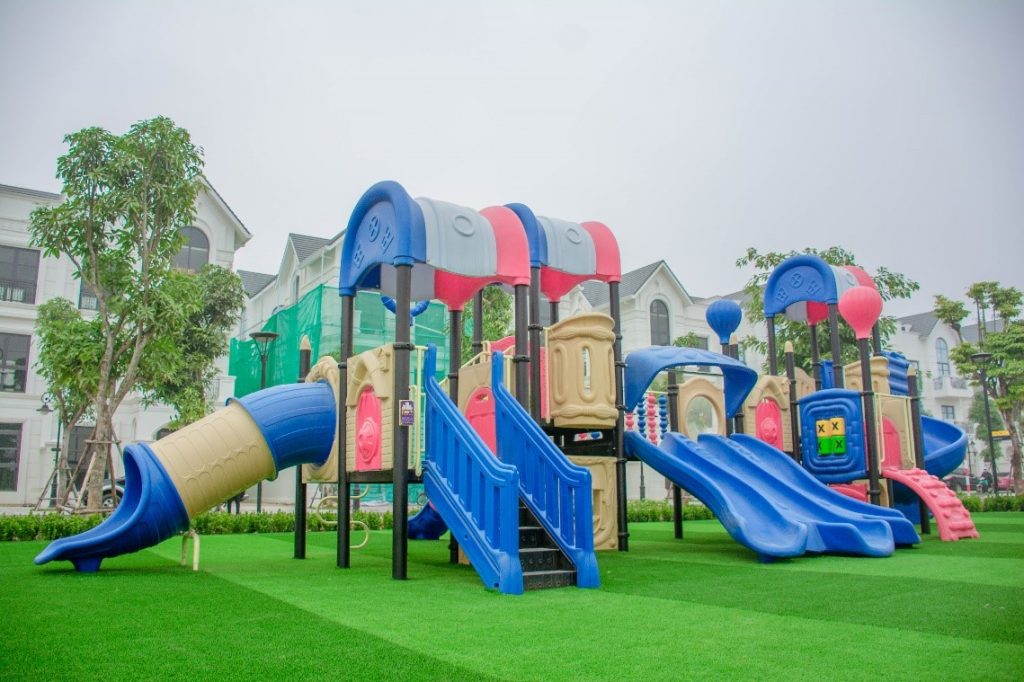Important Criteria To Keep Children’s Playground Safe
Let your child go to the outdoor play area more often to make him feel happier every day; this also helps him exercise his muscles, brain, and social skills. Most importantly, it brings the healthy development of children when playing freely and comfortably.

But for your child to have fun, first and foremost, the playground space and equipment must be safe. So what are the essential criteria to bring a safe play area for children?
- Dimensions of the device
Each playground equipment is suitable for different ages, abilities, levels, and physical abilities of each child. For example, small swings are only meant for younger children to play with but can break if older children use them. And if younger children use equipment intended only for older children, it can be dangerously challenging to play or climb.
- How is the playground surface?
According to the United States Consumer Product Safety Commission (USPSC), each year, emergency departments treat more than 200,000 children for playground-related injuries. Most of these injuries occur when a child falls from play equipment to the ground.
That’s why the best way to prevent injury is to make sure the playing surface is safe and resistant to impact on reducing damage as much as possible. Avoid play areas with complex and unsafe characters such as concrete or asphalt.
Although the grass playing surface looks soft initially, it is not a very impact-resistant surface. The USCPSC recommends that the playground surface be large and wide, made of fine sand materials, or safely tested EPDM grain rubber flooring.
- Climbing equipment
Children often love climbing games. It helps babies build strength, body coordination and gain more insight when seeing their surroundings from a different angle.

However, to avoid as well as prevent risks when playing this game, it should be noted:
- For climbing equipment with a distance of more than 0.7 meters from the ground, it should only be used for older children of school age to play, and there should be barriers or warning signs to prevent falls.
- Always check for sharp corners or edges. For equipment made of wood, check for nails or screws. As for the metal structure, do not let the paint rust or peel off, as the device may contain toxic lead.
- Do not let young children carry unnecessary items when climbing to avoid potential safety hazards.
- Slides
Whether straight, wavy, or spiral, slides bring excitement, thrill, and confidence to children.

However, please note that:
- Slides made of metal can get very hot in the sun and pose a risk of severe burns in children, as can plastic slides. So on hot summer days, look for a fall where there is a cool roof for your baby.
- The slide should have a barrier around it at the top so that the baby can hold it. At the same time, that space also needs to be a bit spacious so that the baby has a safe sitting position before pushing the person to slide down.
- Make sure there are no rocks, glass shards, toys, or any other obstructions at the bottom of the slide. Because it will be dangerous and hinder when the baby slips and lands.
- Teach children how to slide appropriately so as not to injure their heads, and ensure that each child completes the slide one by one so that they can avoid collisions.
- Do not skate with children. Although it sounds safe if you slide with your child, research shows that children’s feet will often get caught or injured during the slide-down process.
- Swings

Swings often help children feel comfortable while forming emotional skills and bonding children to play together better. To prevent your child from getting hurt, you need to:
- Make sure that there are no obstacles before and after the swing area; the grounding surface can withstand the impact force. And the swing bar should be twice the height of the ground to ensure safety when playing.
- Walls, fences, or other objects should be at least 2 meters away from either side of the swing.
- The swing seat must be made of a soft material such as rubber, plastic, or fabric.
- Make sure the swing’s hooks are firm and tight into a figure 8.
- The swing set must securely anchor to prevent it from tipping over.
- Swings should not be placed close to each other. The minimum safe distance between swings is 24 inches and no more than 2 in the same structure of play equipment.
- Do not encourage your child to sway or jump off the swing. Also, teach them not to go near the swing when other kids are playing.
Remember that no matter how safe and age-appropriate the play area is, it does not equal adult supervision and guidance to prevent injury in children.
Researchers show that lack of adult supervision is often linked to more than half of all injuries when playing in children. So when your child climbs, slides or swings, keep an eye on them and be ready to intervene if they are in danger or are using the wrong equipment.
If you are interested and want to learn more product information, don’t hesitate to contact us to discover unique and new products of Viet Play!

